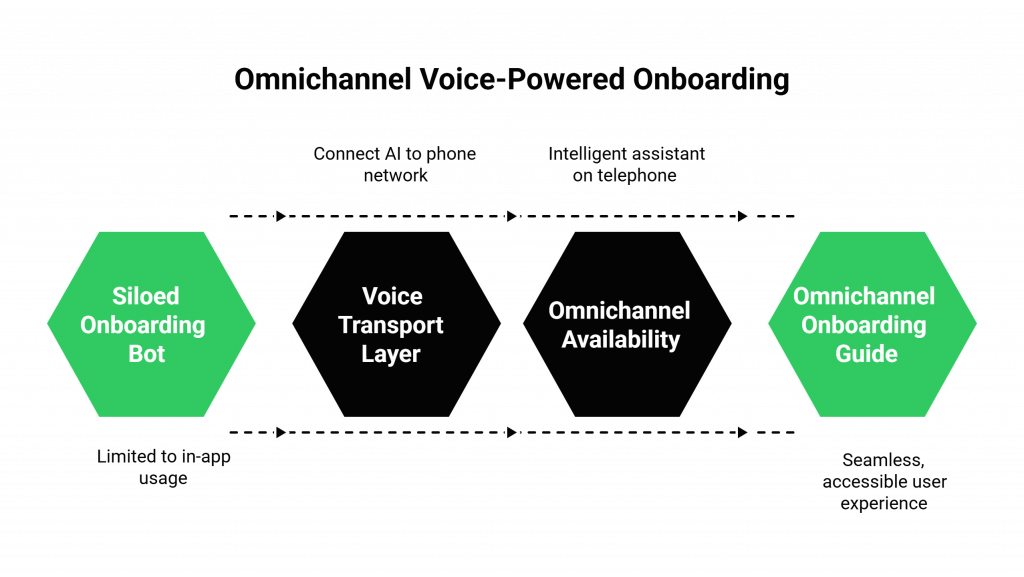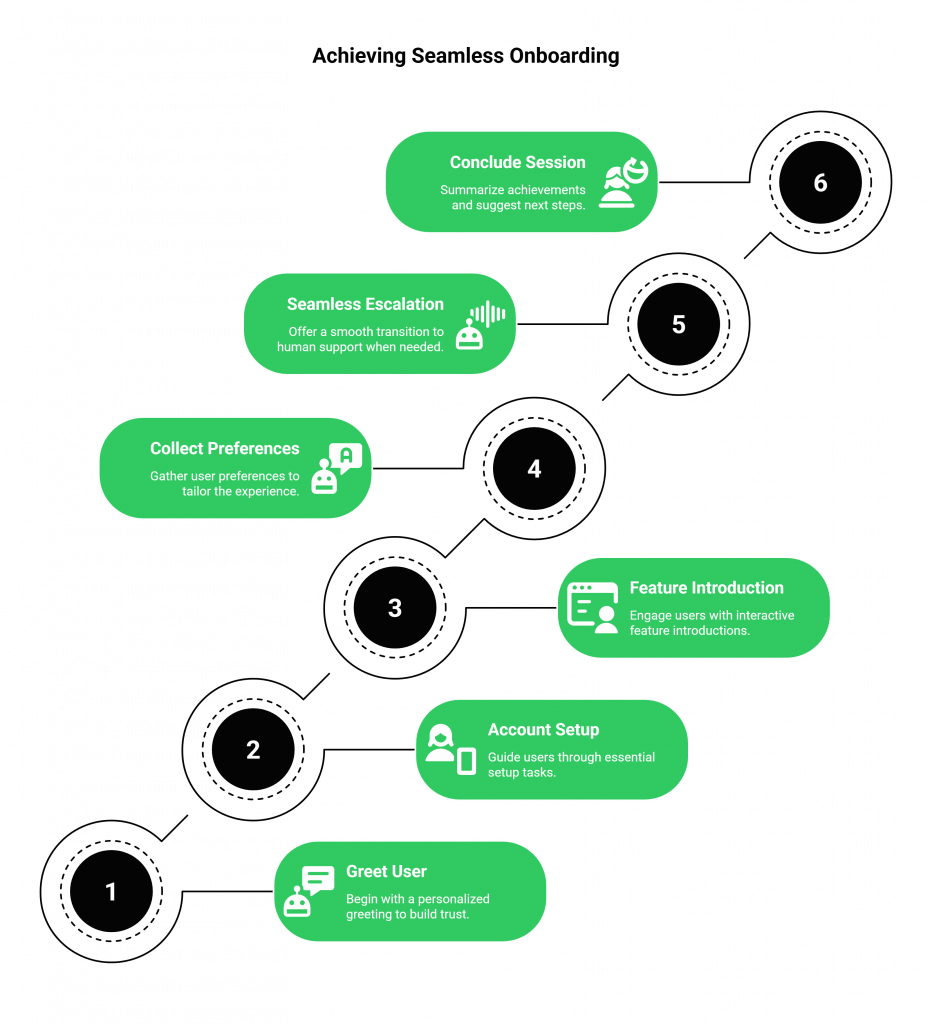The first few moments a new customer spends with your product are the most critical. This is the onboarding window, the make-or-break period where they decide if your solution is a valuable tool or a frustrating waste of time. Get it right, and you create a loyal, engaged user for life. Get it wrong, and they churn before you ever have a chance to show them your product’s true power. For years, businesses have relied on a patchwork of static knowledge bases, passive video tutorials, and clunky text-based bots to guide this journey. The results have been consistently underwhelming.
Table of contents
- Why Traditional Onboarding Fails in the Modern Era?
- The Solution: A Voice-Powered Onboarding Chatbot
- Traditional Onboarding vs. Voicebot-Powered Onboarding: A Comparison
- Designing the Perfect Onboarding Workflow: A Step-by-Step Guide
- Final Thoughts: From a Simple Checklist to a Strategic Asset
- Frequently Asked Questions (FAQ)
Why Traditional Onboarding Fails in the Modern Era?
The goal of onboarding is to get users to their “aha!” moment as quickly as possible. Yet, traditional methods often create more friction than they remove.
- Static Documentation is Overwhelming: New users don’t want to read a 50-page manual. They want immediate answers to their specific questions. Forcing them to sift through dense documentation is a recipe for frustration and abandonment.
- Passive Video Tutorials are Inflexible: A pre-recorded video can’t answer a follow-up question. It can’t adapt to a user’s unique pace or needs. It’s a one-way communication channel in a world that demands two-way interaction.
- Text-Only Chatbots are Limited: While an improvement, text-based bots can feel robotic and slow. They are often unable to handle the nuances of human language and are useless in a hands-free context.
These methods fail because they are not conversational. They are impersonal, inflexible, and unable to provide the real-time, guided support that new users desperately need.
The Solution: A Voice-Powered Onboarding Chatbot
The modern solution is to treat onboarding not as a checklist, but as a conversation. A voice-powered chatbot example for customer onboarding is an AI-driven agent that can listen, understand, and speak to new users, guiding them through every step of the process with natural, human-like interaction.
This isn’t just about adding a voice to an existing bot. It’s about creating a fundamentally different experience.

- It’s Interactive: Users can ask questions in their own words and get instant, context-aware answers.
- It’s Hands-Free: It provides a seamless, accessible experience for users who are multitasking or have disabilities.
- It’s Personal: It can greet users by name, remember their preferences, and tailor the onboarding flow to their specific goals.
However, a truly effective onboarding strategy doesn’t stop at the app. What happens when a user gets stuck later and decides to call your support line? This is where FreJun provides the critical infrastructure. While many platforms can help you build a great in-app voice bot, FreJun ensures that the same intelligent assistant is available on your telephone line. We provide a robust, reliable voice transport layer that connects your AI to the global phone network, transforming your onboarding bot from a siloed feature into a true, omnichannel guide.
Traditional Onboarding vs. Voicebot-Powered Onboarding: A Comparison
| Feature | Traditional Onboarding (Manuals, Videos, Text Bots) | Voicebot-Powered Onboarding (with FreJun) |
| Availability | Limited. Relies on human agent availability or static content. | 24/7. The AI is always available to onboard new users. |
| Interactivity | Low. One-way communication with limited Q&A. | High. A fully interactive, two-way conversation. |
| Personalization | Low. A one-size-fits-all approach. | High. Can greet users by name and tailor the flow to their needs. |
| Scalability | Poor. Onboarding more users requires more human resources. | Excellent. Can onboard thousands of users simultaneously. |
| Consistency | Varies. The quality of onboarding can depend on the agent or the content. | Perfect. Every user receives the same high-quality, accurate information. |
| Accessibility | Limited. Not suitable for hands-free use or users with visual impairments. | High. Fully accessible via voice, both in-app and over the phone. |
| Cost | High. Requires significant manual effort from support teams. | Low. Dramatically reduces the workload on human agents. |
Pro Tip: Use a Friendly and Instructive Tone
When designing your onboarding chatbot example, the personality of your bot is crucial. Use a friendly, welcoming, and instructive tone. The bot’s first words should be a warm greeting that clearly explains its role and sets the user’s expectations. For example: “Hi, [User Name]! Welcome to [Your Product]. I’m your personal guide, and I’ll help you get set up in just a few minutes. You can ask me questions at any time.”
Designing the Perfect Onboarding Workflow: A Step-by-Step Guide
A successful voice onboarding experience is built on a well-designed conversational flow. The goal is to guide the user from A to B with clarity and efficiency. Here is a sample workflow for a best-in-class chatbot example:

Step 1: Greet the User and Set Expectations
The conversation should begin with a personalized greeting. The bot should introduce itself, state its purpose, and give the user a brief overview of the onboarding process. This builds trust and lets the user know what to expect.
Step 2: Guide the User Through Account Setup
The bot should provide clear, step-by-step instructions for essential setup tasks, such as verifying an email address, setting a password, or connecting a third-party account. It should validate the user’s input in real time.
Step 3: Introduce Core Features Interactively
Instead of just listing features, the bot should engage the user. For instance, it could say, “Our dashboard is where you’ll track your progress. Let’s create your first project together. What would you like to name it?” This hands-on approach is far more effective than a passive tutorial.
Step 4: Collect User Preferences and Validate Data
The bot can ask questions to understand the user’s goals and preferences, using this information to tailor the rest of their experience. It should confirm the data it has collected to ensure accuracy.
Step 5: Design a Seamless Escalation Path
No bot can answer every question. A critical part of any onboarding chatbot example is the ability to seamlessly escalate to a human agent. The bot should be able to recognize when it’s out of its depth and offer to connect the user. With FreJun, this handoff is seamless. The bot can transfer the live call, along with the full conversation context, directly to a human agent, so the user never has to repeat themselves.
Step 6: Conclude with a Summary and Next Steps
The onboarding session should end with a clear summary of what has been accomplished and a suggestion for what the user should do next. This provides a sense of achievement and empowers the user to continue exploring the product on their own.
Key Takeaway
A voice-powered chatbot example for onboarding is the most effective way to reduce friction, increase engagement, and improve time-to-value for new users. It transforms a static checklist into a dynamic, personalized conversation. However, for this to be a truly enterprise-ready solution, that conversation must be available on every channel, especially the telephone. FreJun provides the critical voice infrastructure that makes this omnichannel experience possible.
Final Thoughts: From a Simple Checklist to a Strategic Asset
Your customer onboarding process is too important to be left to chance. It’s your first, best opportunity to build a relationship with a new user and set them on the path to success. By moving away from outdated, impersonal methods and embracing the power of conversational AI, you can transform this critical workflow from a necessary evil into a strategic asset.
A voice-powered onboarding experience is more than just a cool feature; it’s a statement about your brand. It says that you are modern, accessible, and deeply committed to your users’ success. The technology to build this experience is here today. Platforms exist to help you design the AI and the conversational logic. But remember, a brilliant bot is only as good as its ability to connect.
By partnering with a specialized voice infrastructure provider like FreJun, you can ensure that your intelligent assistant is not trapped in a digital silo. You can build a truly omnichannel solution that is ready to serve your customers whenever and however they choose to engage.
Don’t just onboard your users. Start a conversation with them.
Further Reading –Backend Guide to Online Voice Bot Implementation
Frequently Asked Questions (FAQ)
Yes. Modern AI, especially when integrated with your product’s backend APIs, can guide users through multi-step processes, validate complex data, and even trigger actions within your application, making it perfect for even the most detailed onboarding.
A well-designed chatbot example includes a clear escalation path. The bot should be able to recognize when a user is frustrated or asking a question beyond its scope and offer to connect them to a live human agent. With a platform like FreJun, this can be a seamless live call transfer.
No. A wide range of no-code and low-code conversational AI platforms are available that allow you to design and deploy a sophisticated voicebot without needing a team of data scientists.
A great voicebot experience is often multimodal. While the user is speaking, the interface can display the transcribed text and the bot’s responses. This allows users to easily switch between voice and text, providing the best of both worlds.
FreJun provides the essential voice infrastructure layer. While other platforms help you build the bot’s AI “brain,” FreJun provides the “body” that connects that brain to the global telephone network. This is critical for creating a true omnichannel experience where the same intelligent bot that helps a user in your app can also answer their call if they need help later.
